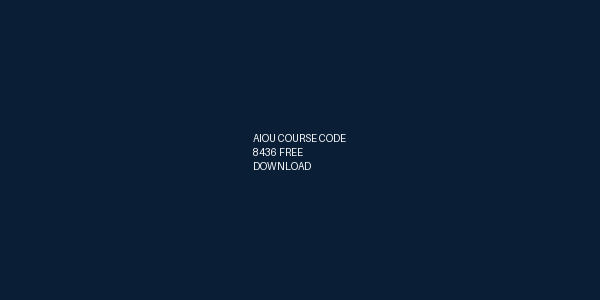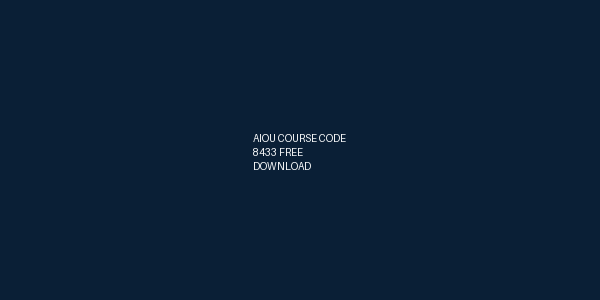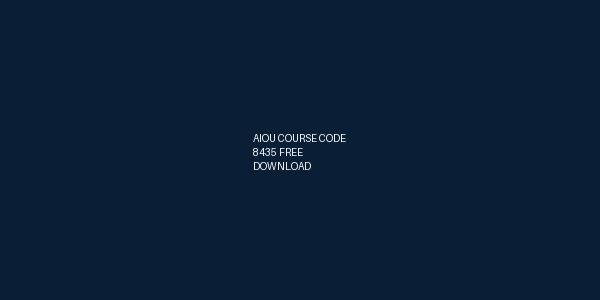AIOU Course Code 8436 Free Download

ALLAMA IQBAL OPEN UNIVERSITY, ISLAMABAD
(Department of Business Administration)
WARNING
- PLAGIARISM OR HIRING OF GHOST WRITER(S) FOR SOLVING THE ASSIGNMENT(S) WILL DEBAR THE STUDENT FROM THE AWARD OF DEGREE/CERTIFICATE IF FOUND AT ANY STAGE.
- SUBMITTING ASSIGNMENT(S) BORROWED OR STOLEN FROM OTHER(S) AS ONE’S OWN WILL BE PENALIZED AS DEFINED IN THE “AIOU PLAGIARISM POLICY”.
Course: Distribution Channel (5090/8530/9546/8436 Semester: Spring, 2025
Level: PGD
Total Marks: 100 Pass Marks: 50
ASSIGNMENT No. 1
- 1 Can you provide an example where a channel manager operates the channel without having total control? (20)
Q. 2 How do specialization and division of labour apply to marketing channels? (20)
Q. 3 What is contractual efficiency, and can you give non-marketing examples of it? (20)
Q. 4 Can product flow operate independently of other channel flows? (20)
Q. 5 What conflicts arise among channel members, and how can they be managed? (20)
ASSIGNMENT No. 2
Total Marks: 100 Pass Marks: 50
This assignment is a research-oriented activity. You are required to submit a term paper and present the same in the classroom before the final examination. The presentation component is compulsory for all students. You will have to participate in the activity fully and prepare a paper of about 15 to 20 pages on the topic allotted to you. The students are required to prepare two copies of Assignment No. 2. Submit one copy to your teacher for evaluation and the second copy for presentation in the classrooms in the presence of your resource persons and classmates, which will be held at the end of the semester before final examination.
Include the following main headings in your report: -
- Introduction to the topic
- Important sub-topics
- Practical aspects for the topic
- Review of theoretical and practical situations
- Merits, demerits, deficiencies or strengths of the organization concerning your topic
- Conclusions and recommendations
- Annex, if any
You must use transparencies, charts or any other material for effective presentation. You are also required to select one of the following topics according to the last digit of your roll number. For example, if your roll number is D-3427185 then you will select topic No.5 (the last digit):-
List of Topics:
- Marketing Channel Density
- Strategy for Physical Distribution
- Supermarket Shopping Behavior
- Logistics Service
- Channel Performance
- International Distribution Design
- Integrating Distribution Channels in the Global Environment
- Market Coverage Policies
- Role of Intermediaries
- Auditing for Channel Performance
DISTRIBUTION CHANNEL
COURSE OUTLINE 9546)
Unit 1 Marketing Channels: Structure and Functions
- Introduction to Marketing Channel
- Marketing Channels Existence and Change
- Work of the Marketing Channel
- Belongs to Marketing Channel
- End User Channel Preferences
Unit 2 Supply-Side Channel Analysis: Channel Flows and Efficiency Analysis
2.1 Channel Flow Defined
2.2 Describing the Current Channel with the Efficiency Template
2.3 Using Channel Flow Concepts to Design a Zero-Based Channel
2.4 Matching Normative and Actual Profit Shares
2.5 Coverage versus Assortment: Framing the Decision of Upstream and Downstream Channel Members
Unit 3 Gap Analysis
3.1 Sources and Types of Channel Gaps
3.2 Closing Channel Gaps
3.3 Pulling It Together: The Gap Analysis Template
3.4 Power: Nature and Balance
3.5 Greatest Source: Reward Power
Unit 4 Introduction to the Business of Banking
4.1 Assessing the Degree and Nature of Channel Conflict
4.2 Consequences of Conflict
4.3 Major Sources of Conflict in Marketing Channels
4.5 Clash of Market Domains
Unit 5 Strategic Alliances in Distribution
5.1 Strategic Alliances: Their Nature and the Motives
5.2 Building Commitment by Greeting Mutual Vulnerability
5.3 Building Commitment by the Management
5.4 Decision Structures That Enhance Trust
5.5 Moving a Transaction through Stages of Development to Reach Alliance Status
Unit 6 Vertical Integration in Distribution
6.1 Introduction
6.2 Costs and Benefits of Vertical Integration
6.3 Deciding When to Vertically Integrate Forward:
6.4 Vertical Integration Forward When Competition is Low
6.5 Vertical Integration to Cope with Environmental Uncertainty
Unit 7 Legal Constraints on Marketing Channel Policies
7.1 Market Coverage Policies
7.2 Pricing Policies
7.3 Product Line Policies
7.4 Selection and Termination Policies
7.5 Channel Institutions
Unit 8 Wholesaling
8.1 Wholesaling Sector: Overview and Sectors
8.2 Federations of Wholesalers
8.3 Voluntary and Cooperative Groups
8.4 Export Distribution Channels
8.5 Franchising
Unit 9 Logistics and Supply Chain Management
9.1 The Impact of Logistics and Supply Chain Management
9.2 Responding Efficiently
9.3 Responding Rapidly
Recommended Book
Coughlan T. A., Anderson E., Stern W. L. And Ansary I. A. (2011). Marketing Channels. New Delhi: Pearson Education.
Additional Readings
Dent, J. (2011). Understanding and Managing Channels to Market. New Delhi: Kogan Page.
Gorchels, L., West, C., and Marien, E.J. (Latest edition) The Manager Guide to Distribution Channels. USA: McGraw-Hills Professional.
Ronsenbloom, B. (2011). Marketing Channels. Mason: South-Western CENGAGE Learning
???

